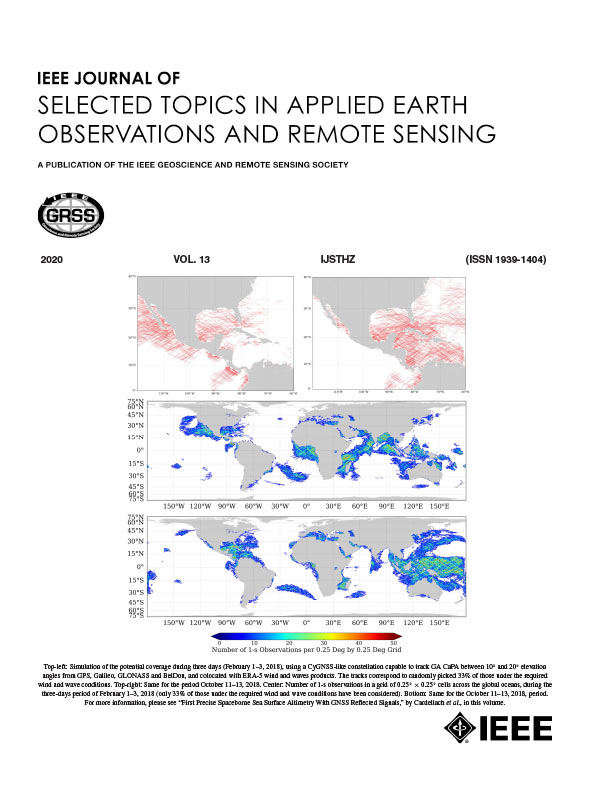用于绘制野火烧伤严重程度图的遥感光谱指数引导的双时相残留注意力网络
IF 4.7
2区 地球科学
Q1 ENGINEERING, ELECTRICAL & ELECTRONIC
IEEE Journal of Selected Topics in Applied Earth Observations and Remote Sensing
Pub Date : 2024-09-13
DOI:10.1109/JSTARS.2024.3460531
引用次数: 0
摘要
野火会对自然生态系统和人类社会造成巨大的破坏和风险。准确、及时地评估野火造成的破坏对于有效的火后管理和恢复至关重要。通过特征工程和机器学习技术,在监测和绘制火灾影响区域地图方面取得了长足的进步。然而,现有的方法往往存在一些局限性,例如人工标注程序复杂且耗时,而且主要侧重于二元分类,只能区分烧毁和未烧毁区域。为此,本研究开发了一种野火燃烧严重程度评估模型 BiRAUnet-NBR,它不仅能准确识别受火灾影响的区域,还能评估这些区域内的燃烧严重程度(低、中、高)。在标准 U-Net 架构的基础上,拟议的 BiRAUnet-NBR 首先纳入了野火前后捕获的位时 Sentinel 2 Level-2A 遥感图像,使模型能够更好地从背景中区分出燃烧区域,并识别由此产生的燃烧严重程度。此外,它还进一步增强了标准 U-Net 架构,融合了更多的光谱层,如从火灾前后图像中提取的归一化燃烧比 (NBR),从而为燃烧区域的检测提供信息。此外,BiRAUnet-NBR 还集成了关注机制,使模型能够更多地关注有意义的特征和燃烧区域,以及解码器模块中的残留块,这不仅显著改善了分割结果,还增强了训练的稳定性,避免了梯度消失的问题。实验结果表明,所提出的模型在野火烧伤区域的多类和二元映射中都具有优势,总体准确率超过 95%。此外,它还优于支持向量机、随机森林、极梯度提升和全卷积网络等基线算法,F1 分数平均提高了 18%,平均交叉比联合提高了 15%。本文章由计算机程序翻译,如有差异,请以英文原文为准。
A Remote Sensing Spectral Index Guided Bitemporal Residual Attention Network for Wildfire Burn Severity Mapping
Wildfires cause substantial damage and present considerable risks to both natural ecosystem and human societies. A precise and prompt evaluation of wildfire-induced damage is crucial for effective postfire management and restoration. Considerable advancements have been made in monitoring and mapping fire-affected areas through feature engineering and machine learning techniques. However, existing methods often exhibit several limitations, such as complicated and time-intensive procedures on manual labeling, and a primary focus on binary classification, which only distinguishes between burned and nonburned areas. In response, this study develops a wildfire burn severity assessment model, BiRAUnet-NBR, which can not only accurately identify fire-affected areas, but also assess the burn severity levels (low, moderate, and high) within those areas. Built upon the standard U-Net architecture, the proposed BiRAUnet-NBR first incorporates bitemporal Sentinel 2 Level-2A remote sensing imagery, captured before and after a wildfire, which enables the model to better distinguish burned areas from the background and identify the severity level of the resulting burns. In addition, it further enhances the standard U-Net architecture by fusing additional spectral layers, such as the normalized burn ratio (NBR) derived from post- and prefire images, therefore, informing the detection of burn areas. Moreover, BiRAUnet-NBR also integrates attention mechanism, enabling the model to pay more attention to meaningful features and burn areas, and residual blocks in the decoder module, which not only significantly improves segmentation results but also enhances training stability and prevents the issue of vanishing gradients. The experimental results demonstrate the superiority of the proposed model in both multiclass and binary mapping of wildfire burn areas, achieving an overall accuracy over 95%. Furthermore, it outperforms baseline algorithms, including support vector machine, random forest, eXtreme gradient boosting, and fully convolutional network, with an average improvement of 18% in F1-score and 15% in mean intersection over union.
求助全文
通过发布文献求助,成功后即可免费获取论文全文。
去求助
来源期刊
CiteScore
9.30
自引率
10.90%
发文量
563
审稿时长
4.7 months
期刊介绍:
The IEEE Journal of Selected Topics in Applied Earth Observations and Remote Sensing addresses the growing field of applications in Earth observations and remote sensing, and also provides a venue for the rapidly expanding special issues that are being sponsored by the IEEE Geosciences and Remote Sensing Society. The journal draws upon the experience of the highly successful “IEEE Transactions on Geoscience and Remote Sensing” and provide a complementary medium for the wide range of topics in applied earth observations. The ‘Applications’ areas encompasses the societal benefit areas of the Global Earth Observations Systems of Systems (GEOSS) program. Through deliberations over two years, ministers from 50 countries agreed to identify nine areas where Earth observation could positively impact the quality of life and health of their respective countries. Some of these are areas not traditionally addressed in the IEEE context. These include biodiversity, health and climate. Yet it is the skill sets of IEEE members, in areas such as observations, communications, computers, signal processing, standards and ocean engineering, that form the technical underpinnings of GEOSS. Thus, the Journal attracts a broad range of interests that serves both present members in new ways and expands the IEEE visibility into new areas.

 求助内容:
求助内容: 应助结果提醒方式:
应助结果提醒方式:


